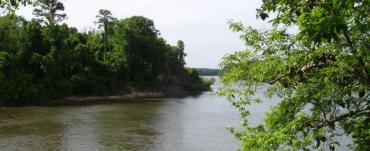
While powerful advocates for rivers east and west of Lake Okeechobee -- the St. Lucie and the Caloosahatchee -- suck the oxygen out of the air in Tallahassee, the embattled Apalachicola in the Florida panhandle is right now "at the breaking point."
The river Florida uncomfortably shares with Georgia and Alabama is a vital and enormously valuable waterway, often forgotten by many Floridians.
But now American Rivers, a national organization that has published endangered-rivers reports since 1984, has named the Apalachicola the most endangered river in the nation and blamed constant withdrawals and disruption for its ranking.
 Rivers are chosen for the list based on 1) the magnitude of the threat, 2) a critical decision-point in the coming year and 3) the significance of the river to people and nature.
Rivers are chosen for the list based on 1) the magnitude of the threat, 2) a critical decision-point in the coming year and 3) the significance of the river to people and nature.
"Most endangered" is a sobering distinction. Florida rivers in trouble have made the list before -- the St. Johns, Suwannee, Peace and others -- but never before has a Sunshine State river topped the annual list.
The truth is, most of the rivers in development-choked Florida are mismanaged and ailing, and a far shorter list would be Florida waterways that are healthy and thriving.
But the Apalachicola, the state's largest river, has suffered from a special kind of neglect and bad history.
“The Apalachicola River may be the most important river in the United States that most Americans are not familiar with,” said Bob Graham, former governor and U.S. senator. “The Apalachicola played a significant role in the history of the south and nourishes the Apalachicola Bay, one of the world’s most productive estuaries.
"This estuary, and the special economy and way of life that it supports, is dependent upon a sustained flow of fresh water from the River mixing with the salt waters of the Gulf of Mexico. Tragically, in recent years, the mismanagement of the Apalachicola-FlintChattahoochee Basin has led to the collapse of this vital environmental and economic resource," Graham said.
Apalachicola Riverkeeper Dan Tonsmeire identifies four fundamental threats to the health, ecological productivity, and biological diversity of the river and bay, and to the lives and livelihoods of the thousands of people who depend on these resources:
- Loss of life-sustaining freshwater
- Loss of floodplain and wetland habitat
- Point-source and nonpoint-source pollution, and
- Unrestrained growth and development.
Apalachicola Bay oysters have significantly declined in recent years, not only because of overharvesting, but because of a lack of sufficient freshwater flows in the Apalachicola River. Scientists say the culprit in freshwater decline is the reduction in water siphoned off from the river in Georgia.
Since 1990, control of water in the river system shared by Florida, Georgia and Alabama has been the subject of lengthy litigation. In the fall of 2013, Gov. Rick Scott announced a new lawsuit against Georgia in the U.S. Supreme Court and that challenge is continuing.
American Rivers said in its report, "Outdated water management and spiraling demand" (for the river's fresh water) are the basis for the ranking. The group called on the governors of the three states to act "swiftly" to form a water-sharing agreement that protects the rivers, and for the U.S. Army Corps of Engineers to reboot its operating plan for the entire river system.
The river forms where the tributaries of the Flint and Chattahoochee join at the Florida-Georgia line. The river then flows south more than 100 miles to Apalachicola Bay and once thriving oyster country.
During the past five years, the Apalachicola oyster population has gone into dramatic decline, plummeting in August 2012 to the point where the creatures almost disappeared.
Not long ago, the bay produced 90 percent of the oysters in Florida and 10 percent of the national supply. But Florida is losing the water wars, and the oystermen are losing their jobs and their livelihoods as a result.
With passage of 2014's Land and Legacy Amendment, millions of dollars are committed to environmental problems in South Florida. Certainly the projects are worthy, every one of them.
But shouldn't legislators look at all of Florida's rivers as a critical whole, allocating recurring money and pressuring Florida's congressional delegation to keep after the U.S. Army Corps of Engineers and other responsible federal agencies? Curing our rivers' ills requires a dedicated effort and leadership, as Gov. Rick Scott began when he and Attorney General Pam Bondi sued the state of Georgia. We need more of that, not as a one-off effort, but as a rule.
Reach Nancy Smith at nsmith@sunshinestatenews.com or at 228-282-2423. Twitter: @NancyLBSmith


